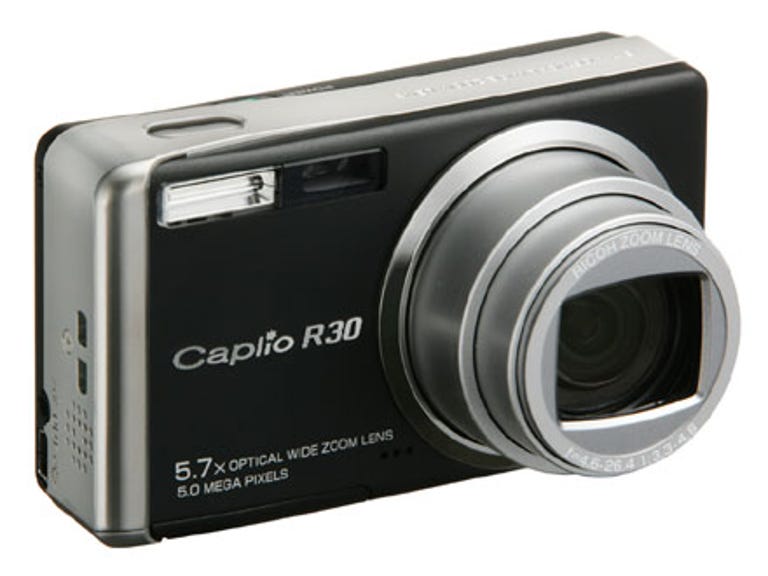 Why You Can Trust CNET
Why You Can Trust CNET Ricoh Caplio R30 review: Ricoh Caplio R30
While it may not have a single standout feature, the R30 is a solid performer in a crowded 5 megapixel digital camera market.
Design
While some vendors opt to experiment with lenses that remain inside the camera body, the R30 sits firmly in the traditionalists camp, with a sizeable lense extending once powered on. However this isn't to the detriment of speed, with the device ready to go in an instant.
The Good
The Bad
The Bottom Line
On the other side of the camera, a four-way directional pad is the main interface for operation. There are dedicated buttons for zoom, picture review, adjustments, delete/timer, and display modes for the 2.5 inch LCD screen. A small switch is used to select between photo, video and sound recording functions.
Continuing Ricoh's trend for small form factor cameras, the 95 x 26 x 53 mm R30 easily sits in your pocket without weighing you down.
Features
Ricoh is keen to tout the R30's 5.7x (28mm wide-angle - 160mm telephoto) optical zoom lens, which gives it a good foothold in the crowded 5 megapixel market.
If you intend to record a lot of video, the R30 can shoot 320x240 pixel movies at 30 frames per second; stock-standard among digital cameras today. At this frame-rate, you'll only be able to store about 40 seconds of footage on the R30's internal memory (26MB). However, an SD card slot allows for expansion.
Nine scene modes allow you to tailor the lense to your shooting situation. These include high sensitivity mode, for recording in dark places, and skew correction mode, whereby the camera can adjust a photographed subject as if it were shot squarely.
Macro mode allows you to shoot a subject from 1 centimetre away, although this has been a standard function of Ricoh cameras for some time.
 The LCD screen can be customised (click for larger image) |
While 2.5 inch LCD screens are common among digital cameras today, Ricoh has done a nice job of allowing for customisation. Screen brightness can be altered in case of outside glare etc, and so too can the size of text and on-screen icons. As there is no viewfinder on the R30, this is an important function.
Once you've transferred your images from the camera to your computer, the included 'ImageMixer' software is a handy tool for media production. ImageMixer helps to manage your photos in an album, and can edit your sounds and videos, as well as burn them to CD.
Performance
We found it necessary to use the half-press auto-focus mode most of the time when using the R30, as opposed to the normal full-press shot. Full-press shots were prone to blurring, only made more interesting by the manual's admission that -full-press is apt to cause the camera to shake". This led us to notice the absence of any anti-shake function, which some cameras have for unstable shooting conditions. While perhaps not the best camera then for those needing to shoot suddenly (sports photographers etc), most of the shots we took were of excellent quality.
Skew correction mode was fairly easy to operate, but it should be pointed out that this feature is only for squarish subjects. Levelling tilted photos of your friends or family won't happen, as this mode can only be used on subjects like bulletin boards, framed objects and cards.
A feature that wouldn't have gone astray though is USB 2.0 connectivity. The R30 can take around 300 shots on one charge, and when you consider that sometimes you may want to record video and sound, this can take some time to download to your computer.
As is the case with most of today's cameras, the R30's battery life was impressive. We gave it a thorough workout over several days, constantly powering the device on and off and making full-use of the LCD screen. Yet it seemed to be an age before the first light of the battery meter disappeared.
Being familiar with some past Ricoh models, it's also noticeable that not a great deal has changed on the Ricoh LCD interface over the last year or two. While some might interpret that as a lack of innovation, we see it as a case of 'if it ain't broke, don't fix it', with anyone who's used a Ricoh in past likely to be shooting the R30 with confidence after a few minutes.
